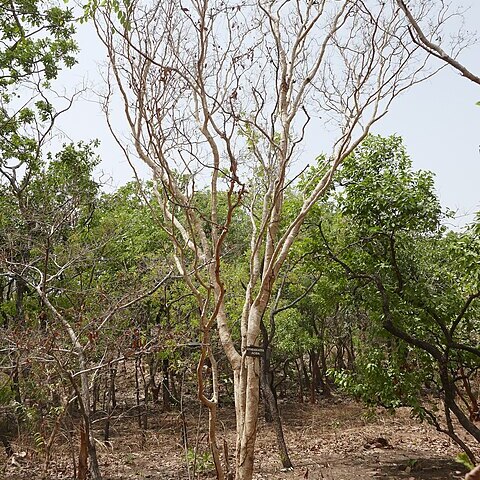Leaf blades 2.5–9.5 × 1.5–5 cm, elliptic-ovate to oblong-oblanceolate, rounded, obtuse or rarely subacute at the apex, rounded or sometimes cuneate at the base, thinly coriaceous at maturity, dark green above, paler beneath; upper surface sparingly or evenly pubescent to subglabrous; lower surface densely subferruginous-or fulvous-tomentose, or subglabrous except along the midrib and main nerves and the domatial hair tufts, sparingly to evenly gland-dotted; lateral nerves in 5–8(10) pairs, fairly prominent and camptodromous on leaf lower surface, scarcely prominent on upper surface and brochidodromous.
A shrub or small tree. It grows up to 6 m high. The bark is light brown, smooth and flaky. Young branches are rust coloured. Leaves are oblong. They are 2.5-9 cm long by 2-4 cm wide. They have brown velvety hairs. The flowers are separate sexes on separate trees. Male flowers are reddish in spikes up to 6 cm long. Female flowers are green. Each one looks like a small fruit with 2 long red forked styles. They can be single or in clusters. The fruit is a flattened capsule with 2 wings. These give the shape of a heart. These become red when mature.
Female flowers: pedicels 1 mm long, extending to up to 2 cm long in fruit; sepals 5–9, 1.5–4 mm long, free or sometimes partially united, linear, usually readily caducous, pinkish; ovary 2 × 1 mm, obovoid-oblong to obcordate, 2-winged in the upper half, gland-dotted, glabrous or densely pubescent, glaucous or crimson; styles 2(3), 0.2–2 cm long, the arms 0.25–1 mm thick, filiform, rugose-papillose, reddish-purple.
Fruits borne on a stipe 2 mm long, flat, 2–3.5 × 2.3–4 cm, V-shaped, with 2 apical divergent rounded-rhomboid membranous striate wings, rounded or cordate at the base, reticulate, glabrous or pubescent, gland-dotted or not, somewhat shiny, yellow-green at first, turning pink then reddish-brown, dehiscent into 2 subtrapeziform cocci leaving a compressed-fusiform columella.
A shrub or small tree up to 10 m high, often straggling or untidy; crown flat or rounded; upper branches spreading, lower branches drooping; bole 15–30 cm in diameter at breast height, often stunted or contorted; bark smooth, light brown or grey, flaking off to leave a powdery rufous or fulvous underbark.
Male flowers: buds open, deep reddish-carmine or brownish; calyx 1.5–2 mm across, shallowly 5-lobed, the lobes obtuse, ciliate, pinkish; anthers 1.2 mm long, dorsally purplish-tinged, pollen pale yellow; pistillode 2-lobed, 1 mm high.
Male inflorescences 2–7 cm long, densely spicate, amentiform, the spikes solitary or fasciculate in the axils of fallen leaves; axis pubescent; bracts 1 mm long, spathulate, ciliate.
Female flowers axillary or solitary, or in few-flowered racemes up to 3 cm long terminating lateral leafy shoots; axis and bracts ± as in the male.
Seeds 1 × 0.5 cm, compressed-semicircular, smooth, shiny, dark purplish-brown streaked with black.
Stipules 1–3 mm long, linear-lanceolate to filiform, pubescent, soon falling.
Young shoots and petioles pubescent or puberulous, glabrescent.
Branchlets becoming rusty-powdery when the bark peels off.
A savannah shrub or small tree about 20 ft. high
Petioles 0.2–1.6 cm long.


